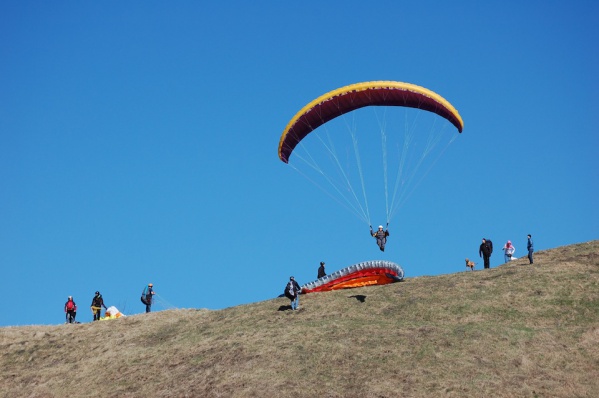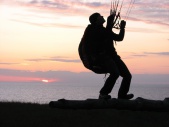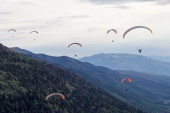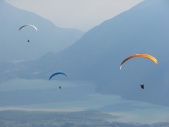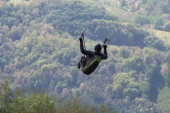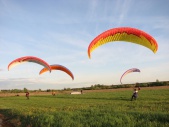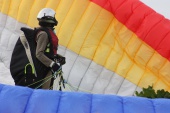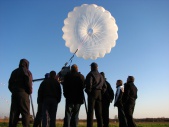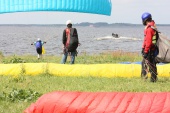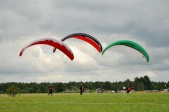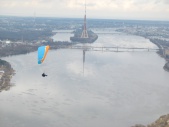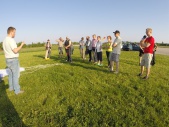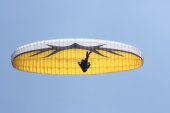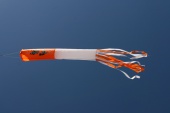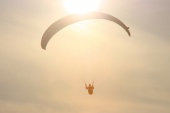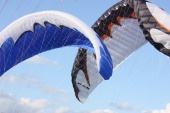School
Training Programme
The training consists of two courses.
The practical part of the training is taking place at the Aerodrome of Rumbula in the presence of an instructor only.
Course 1:
- 10 practical training on a grounded paraglider until a level of skills is reached which enables to start flying
- Theory (Lecture 1 and 2)
- A practical training lesson on the reserve parachute (Lecture 3)
- 2 tandem flights with the instructor
- 12 solo flights
Course 1 is designed to master elementary skills: controlling the paraglide on the ground, launching correctly, climbing, landing, the basic principles of paragliding, mid-air turns, and simulation of reserve parachute deployment.
Upon completion of Course 1 a student will have already formed his opinion about this type of sport and will have to decide whether or not to continue the training to become a pilot upon completion of the training programme. If the answer is ‘Yes, I like it’, the student will start Course 2 to acquire the skills necessary for a pilot. The student must also bear in mind that he or she will have to purchase equipment of his own to fly upon completion of the training.
Course 2:
- The theory of meteorology, aerodynamics, mid-air situations, Latvian airspace usage regulations etc. (Lecture 4 and 5)
- 20 solo flights (exercises: pitch control, rotations – light spiral, wingovers, precision landing, ‘big ears’, landing with ‘big ears, use of the accelerator)
- 3 flights in tandem with instructor to safely understand the dynamics of the spirale maneuver
School take-offs and landings are filmed to give the student a broader understanding of the process. If necessary, videos are analyzed.
School equipment is used during all practical training, and there are NO additional costs to pay. A student is entitled to a training discount in case he has equipment of his own.
During the solo flights, a student does not just learn to fly but also performs and learns different manoeuvring techniques which will enable him to fly safely in the future. Radio communication is provided during the flights (the instructor helps the student to perform the exercises by means of a walkie-talkie).
Upon completion of the training a student takes an examination given by a representative of the Latvian Paragliding Federation (the LPF) and gets an international pilot proficiency information (IPPI) card certifying that the pilot has mastered ParaPro Level 3 for autonomous paragliding.
Category classifier
Theory lessons and lectures take place indoors. Practical training takes place at the Aerodrome of Rumbula on weekdays, normally from 5:00 p.m. till it gets dark, weather permitting, from early April till late September. In the spring and autumn the training also takes place during daytime if there are students who can come over in the middle of a workday. In the summer airflows are too strong to take School flights during the day. Weekends are club days and the club normally does thermal flights outside Riga (e.g. in Jekabpils) because a higher flight altitude is allowed there. There is a condition, however: if a student comes over on the club day, he or she may fly in turn, provided an instructor is keeping an eye on the student.
The training does not include flights in dynamic air flows. This is the next level of flying skills because one must fly accurately and with a sense of what one is doing. Here, one cannot proceed without a previous minimum flight experience acquired at the School. One can master flying skills in dynamic air flows at Jurkalne or, less often, in Skriveri, in the ideal case, under the supervision of an instructor. Club pilots are willing to help beginners if they show initiative by themselves.
